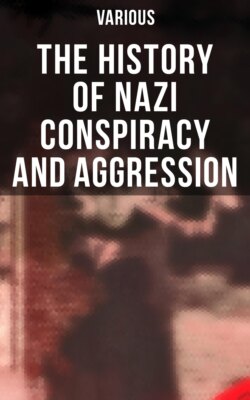Читать книгу The History of Nazi Conspiracy and Aggression - Various - Страница 97
На сайте Литреса книга снята с продажи.
Оглавление“I am just reading in the VOELKISCHER BEOBACHTER, edition 235/236, page 1, an article entitled “Does Wirth intend to come over?” The tendency of the article is to prevent on our part a crumbling away from the present form of government. I myself am travelling all over Germany to achieve exactly the opposite. May I therefore ask that my own paper will not stab me in the back with tactically unwise articles * * *” (047-PS).
Captured film enables us to present the defendant, Alfred Rosenberg, who from the screen will himself tell you the story. The SA practiced violent interference with elections. We have the reports of the SD describing in detail how its members later violated the secrecy of elections in order to identify those who opposed them. One of the reports makes this explanation:
“The control was effected in the following way: some members of the election-committee marked all the ballot papers with numbers. During the ballot itself, a voters’ list was made up. The ballot-papers were handed out in numerical order, therefore it was possible afterwards with the aid of this list to find out the persons who cast no-votes or invalid votes. One sample of these marked ballot-papers is enclosed. The marking was done on the back of the ballot-papers with skimmed milk * * *” (R-142).
The Party activity, in addition to all the familiar forms of political contest, took on the aspect of a rehearsal for warfare. It utilized a Party formation, DIE STURMABTEILUNGEN, commonly known as the SA. This was a voluntary organization of youthful and fanatical Nazis trained for the use of violence under semi-military discipline. Its members began by acting as bodyguards for the Nazi leaders and rapidly expanded from defensive to offensive tactics. They became disciplined ruffians for the breaking up of opposition meetings and the terrorization of adversaries. They boasted that their task was to make the Nazi Party “master of the streets.” The SA was the parent organization of a number of others. Its offspring include DIE SCHUTZSTAFFELN, commonly known as the SS, formed in 1925 and distinguished for the fanaticism and cruelty of its members; DER SICHERHEITSDIENST, known as the SD; and DIE GEHEIME STAATSPOLIZEI, the Secret State Police, the infamous Gestapo formed in 1934 after Nazi accession to power.
A glance at a chart of the Party organization (Chart No. 1) is enough to show how completely it differed from the political parties we know. It had its own source of law in the fuehrer and sub-fuehrers. It had its own courts and its own police. The conspirators set up a government within the Party to exercise outside the law every sanction that any legitimate state could exercise and many that it could not. Its chain of command was military, and its formations were martial in name as well as in function. They were composed of battalions set up to bear arms under military discipline, motorized corps, flying corps, and the infamous “Death Head Corps”, which was not misnamed. The Party had its own secret police, its security units, its intelligence and espionage division, its raiding forces, and its youth forces. It established elaborate administrative mechanisms to identify and liquidate spies and informers, to manage concentration camps, to operate death vans, and to finance the whole movement. Through concentric circles of authority, the Nazi Party, as its leadership later boasted, eventually organized and dominated every phase of German life—but not until they had waged a bitter internal struggle characterized by brutal criminality. In preparation for this phase of their struggle, they created a party police system. This became the pattern and the instrument of the police state, which was the first goal in their plan.
The Party formations, including the Leadership Corps of the Party, the SD, the SS, the SA and the infamous Secret State Police, or Gestapo—all these stand accused before you as criminal organizations; organizations which, as we will prove from their own documents, were recruited only from recklessly devoted Nazis, ready in conviction and temperament to do the most violent of deeds to advance the common program. They terrorized and silenced democratic opposition and were able at length to combine with political opportunists, militarists, industrialists, monarchists, and political reactionaries.
On January 30, 1933 Adolf Hitler became Chancellor of the German Republic. An evil combination, represented in the prisoners’ dock, by its most eminent survivors, had succeeded in possessing itself of the machinery of the German Government, a facade behind which they thenceforth would operate to make a reality of the war of conquest they so long had plotted. The conspiracy had passed into its second phase.
